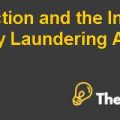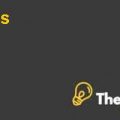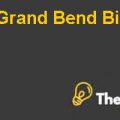The Murray Ohio Manufacturing Company Case Study Solution
Financial Statement Analysis
By performing the ratio analysis, we can determine that whether the company can maintain its current dividend policy or not.
Ratio analysis is defined as the analysis of financial statement which gives a quick review of the company’s performance. Ratiosare mainly categorized in profitability ratios, solvency ratios, gearing ratios and performance ratios.(Business Finance)
Profitability Ratios:
Profitability ratios define the ability of the company to generate income in contrast with the expenses. Mainly gross profit margin and net operating profit margin are used to analyze the profitability status of the company.(Osteryoung, Constand, & Nast, 1992)
The gross profit margin of Murray Ohio Manufacturing Company decreases during the period of1982-1984 from 14.98% to 12.57%.Although the gross profit margin decreases during this period but it is still at a good position as the net profit margin of the company increases from 3.05% to 3.09% this indicates that the company effectively maintains its expenses and hence perform well in depressed condition.
Performance Ratio:
Performance ratios measure the effectiveness of the company.These ratios reveal that how well a company uses its resources to generate income along with this, these ratios also indicate that how well a company manages its operations. To analyze the performance of the company we mainly calculate the ROA, ROE, inventory turnover days, receivable turnover days and payable turnover days in the short working capital.(Nina Ponikvar, 2007)
The ROA and ROE of the company increased significantly in 1983 however, in 1984,they decreased. But if we compare these ratios with the performance of 1982, then we can say that both of these ratios increased by approximately 0.65% hence we can conclude that the company uses its assets effectively to generate earnings. On the other hand, the cash-to-cash cycle decreases from 152 to 126 days.The decrease is mainly due to the decrease in inventory turnover days which indicates that the company uses prudent steps to convert its inventory into cash. However, there is adverse movement in receivable and payable days which may create problems in the long run.
Gearing Ratios:
Gearing ratios measure the financial leverage of the company such that it demonstrates that how much capital structure of the company is funded by equity and how much by debt. To analyze the gearing position of the company we calculate leverage and interest coverage ratio of the company.(Tobias Adrian, 2010)
The leverage of the company improves with the passage of time.It decreases from 2.17 to 1.79 in 1984.We calculate this ratio by dividing average assets with the average equity. Along with this the gearing of the company decreases from 37% to 28% in 1984 which indicates that the company has a low risk. Moreover, the interest coverage ratio of the company also improves with time and increases to 2.95 from 2.38 in 1984 which indicates that the company has enough earnings to pay out its interest expense.
Free Cash Flows:
Free cash flow measures the financial performance of the company and it is calculated through using operating incomes and capital expenditures. It is the cash which can be used by the company in any manner to grasp emerging opportunities and to pay out dividend or etc.(Larry H.P, 1989)
The free cash flows of the company are approximately $10576903, $19368602 and $2537397 in 1982, 1983 and 1984. To calculate free cash flow we assume that the required working capital is 1% of sales revenue.See Exhibit 1
Concern:
From the ratio analysis we can conclude that the company performs well in the current year.It has good profitability and gearing position, therefore,it should payout the dividend. Furthermore,as the company has a norm that it pays regular dividend from the last 49 years, therefore,it should not break this sequence because breaking may jeopardize the confidence of the shareholders. Along with this free cash flow indicates that the company has enough cash to pay adividend. From the calculation of free cash flow we determine that the company can pay $0.65 dividend per share to its shareholders while in 1980 company paid $1.20 dividend per share to its shareholders.Although the dividend per share is lower than the previous years but the company is in the position to pay out the dividend, therefore, it should pay. However, by analyzing these situations, we can say that if the operating condition remains same then the company cannot maintain its current dividend policy in the future.
- Evaluate management’s business strategy for the future. What does this strategy imply for the company’s future cash requirements? Given this new strategy, is the company more or less likely to maintain its current dividend policy?
In 1984, Murray Ohio’s mower sector sales had increased by 15% while bicycle sector sales had decreased by 19%. To improve the future performance of the company Murray Ohio suggests four steps
- Adopting an aggressive bicycle pricing structure to regain market share
- Improving manufacturing productivity through process modernization, manufacturing resources, planning and better manpower utilization
- Introducing new and innovative product, including the new Sabre mower line aimed at the power equipment dealers and
- Working with other domestic producers to lobby the U.S Congress to increase import tariffs on a bicycle......................
This is just a sample partial case solution. Please place the order on the website to order your own originally done case solution.













